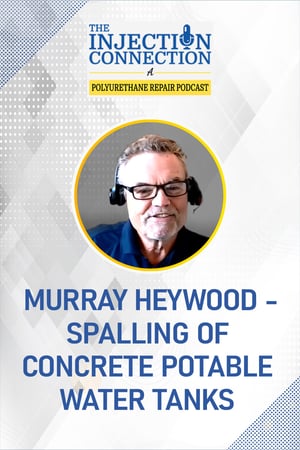
 This article is an excerpt from Episode 14 of Alchemy-Spetec's podcast The Injection Connection, featuring veteran coatings expert Murray Heywood. (If you'd rather view or listen, an audio/visual version of this excerpt is posted at the bottom of the article.)
This article is an excerpt from Episode 14 of Alchemy-Spetec's podcast The Injection Connection, featuring veteran coatings expert Murray Heywood. (If you'd rather view or listen, an audio/visual version of this excerpt is posted at the bottom of the article.)
Charlie Lerman: There's something I always say and I want to run it by you because you could verify or tell me if I’m wrong on this. When you look at potable water tanks, those things are typically like three feet thick and they're chock-full of rebar. They're just stuffed full of rebar, so any type of drilling crack injection on them is just nightmarish. A lot of people don't like to do that. Normally what you get when those things leak, is that you just have a hairline crack because you have so much concrete in there. What I imagine happens a lot of times is that you have people come in with hydraulic cement. They rub that out, but you still then have three feet of concrete with water all the way through it. And all that reinforcing steel potentially rusting. You mentioned the freeze-thaw effect, and that's about 12 times expansion when water freezes.
Murray Heywood: Yes.
Charlie: But when you look at corrosion, N.ACE has put out that it's about seven or eight times expansion when the steel rusts.
Murray: Yes.
Charlie: So, it's not as dramatic as freeze-thaw but still, six times is going to blow up the concrete.
Murray: Well, you've got to remember that if you have rebar, it will expand about seven times but the tensile strength of concrete is very weak. Concrete does not hold itself together very well. It doesn't take much to start that expansion happening and to make the problem worse. So you have to keep the moisture out as much as possible. The thing with potable water, especially concrete potable water tanks, and ground storage tanks, is that if you want to become very unpopular, go into an AWWA, D110 prestressed concrete tank committee and mention protective coatings. They want to string you up because they want to sell it as maintenance-free and that you don't need to line it. And truly, they don't need to line it - except for when you start to get some deterioration and then you get water in. And once water gets in, then that whole deterioration is expedited. So you've got to keep the moisture out and you want to keep it away from the rebar. When you're talking about potable water tanks, a lot of them are engineered and pre-cast. But when you get into wastewater treatment plants, you'll find a lot of times mistakes are made and the rebar is too close to the surface. And then any water that gets in is going to create that issue much quicker because that rebar is going to get more moisture. It's going to expand quicker and cause more damage. So I think that where you see more need for grouting in the potable water world is in the treatment plants again because a lot of these plants are getting long in the tooth. Their concrete has a 50-year design life and we have no money to replace it. We barely have money to fix it. So I think grouting plays a role in both wastewater and water but certainly, on rebar you're correct - you've got to stop that moisture.
View the video version of this excerpt...



